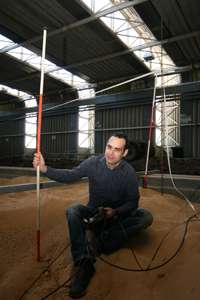Dr. Assaf Klar of the Technion Faculty of Faculty of Civil and Environmental Engineering is developing a way to detect and pinpoint the excavation of tunnels, such as those used for smuggling weapons into Gaza.
(PhysOrg.com) -- With the same type of fiber optic cables used in telecommunications systems, researchers from the Technion-Israel Institute of Technology have developed a way to detect and pinpoint the excavation of tunnels during times of war, such as those used for smuggling weapons into Gaza. The findings will be presented at the Defense, Security and Sensing Conference of SPIE (an international society advancing light-based research) in April 2009 in Orlando, Florida.
Principal researchers Dr. Assaf Klar and Dr. Raphael Linker, both of the Technion Faculty of Civil and Environmental Engineering, say the system is capable of locating even narrow tunnels at depths greater than 60 feet with a limited number of false alarms.
"Tunnel excavation is accompanied by the release of stresses that cause permanent - though very tiny - displacements and strains in the ground," says Dr. Klar. "If you can measure these strains in the soil with sensitive equipment, you can find the tunnel's location." Tunnel excavation has a distinctive signal that is very different from those of disturbances, he adds.
The research lays the groundwork for the initial stages of an underground fence based on an existing technology called BOTDR (Brillouin optical time domain reflectometry) that makes it possible to measure fiber distortion along 15 miles using one device.
The proposed system is based on "wavelet decomposition" of the continuous BOTDR signal, a process that breaks down the signal profile into simpler shapes, and then filters out any irrelevant signals ("noise"). The signals that remain are then characterized by a neural network that has been trained to locate tunnels using computer simulation of tens of thousands of profiles, including disturbances not related to tunneling (examples include raindrops).
"The ability of the BOTDR approach to supply a continuous profile of soil distortions along the fiber optic line - and the ability of the neural network to identify the relevant profile that characterizes the excavation - are the keys to the system's success," says Dr. Linker.
Provided by Technion-Israel Institute of Technology
























